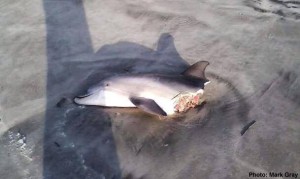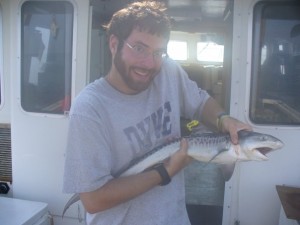One of the many perks of spending lots of time on boats is that you get to overhear some pretty strange radio conversations. The strangest I ever heard took place in the summer of 2002 in the Gulf of Maine, when the captain of a fishing vessel was calling the Coast Guard to report that he was looking at half of a dolphin swimming around. I was shocked, but the Coast Guard radio operator had apparently heard of this, and replied, “No, sir, that’s a mola mola. It’s a fish, and it’s supposed to look like that.” Everyone on the bridge of the sailing vessel I was on laughed.
I hadn’t thought about the idea of “half of a dolphin” for more than 10 years… until last week, when I saw this photo of an animal which had washed up on Folly Beach, South Carolina, only a few miles from where I used to live (and swim). According to marine mammal expert Wayne McFee of NOAA’s National Centers for Coastal and Ocean Science, this is the second time in recent weeks that half a dolphin has washed up on the shores of South Carolina. Although more than twice the average number of dolphins have stranded in South Carolina this year, seeing two bitten in half ” is an unusual occurrence,” he told me.

Unusual indeed. What could do this to a bottlenose dolphin? Though this individual was a juvenile, adults of this species can grow over eight feet in length, can swim almost 20 miles an hour for short bursts, and are frequently found in large social groups. Katheryn Patterson, a Ph.D. candidate studying dolphins at George Mason University, notes that “sharks, orcas, and humans are known predators of dolphins. It is rare that a bottlenose dolphin would be killed by a shark, but larger species of sharks have been reported to kill them.” Smaller species of dolphins are bitten by sharks more regularly.
There are no orca whales off the coast of South Carolina, but Bryan Frazier, chief scientist of the South Carolina Department of Natural Resources Shark Survey, told me that “several species of large coastal sharks capable of preying on dolphins are abundant in coastal SC waters. Mature bull and tiger sharks are common where the carcasses have been found, and great whites are also seasonally present.”

Bryan pointed out that bull and tiger sharks are usually not found in South Carolina waters this time of year due to colder temperatures, and therefore “the most likely culprit would be the great white shark.” Dr. Bob Hueter, Director and Senior Scientist of the Center for Shark Research at Mote Marine Laboratory, agrees with Bryan. “Photos indicate large bites by a good-sized predator, not the work of smaller scavengers. We know through the data shown on Ocearch’s Shark Tracker that large white sharks are visiting this coast this time of year. These sharks do prey on marine mammals, including seals to the north and whales off the southeast US. So the idea that one or more white sharks are responsible for the observed predations on bottlenose dolphins off South Carolina is not the only possibility but is certainly a plausible one.”
Wayne McFee confirmed that both individuals that washed ashore showed evidence of being bitten by a shark. Results from a histopathology test performed during the necropsy haven’t yet determined if these bites are what killed the dolphins or if they were scavenged post-mortem, though scavenging may be more likely. Katheryn Patterson told me that bottlenose dolphins “will often form groups when threatened by a predator, keeping with the idea of safety in numbers. Female bottlenose dolphins tend to associate with other females in smaller groups, where males tend to be solitary or form an alliance with one another male.” It’s almost impossible to tell the sex of an animal when the back half is missing, but she suspects that these individuals were “solitary at the time of the attack and are already weakened or injured in someway.”
It’s possible that the dolphins were weakened by the morbilivirus which has been blamed for hundreds of marine mammal deaths this year. Tissues have been sent off for analysis, but the process takes weeks and hasn’t yet been completed.
We may never know what happens to these particular dolphins, but the most likely explanation is that they were weakened or killed by morbilivirus before being bitten by a great white shark. More information may come in later, but in the meantime, one important lesson can be learned. If there was ever any doubt that the facial shape of a bottlenose dolphin is not, in fact, a smile indicating that they are happy, it’s gone now.
Very good article. We have no white sharks down where I am at and invariably we see some of these same incidents every year; mostly calf or juvenile bottlenose dolphins (never seems to be any other species although we have a plentiful abundance of variety). I keep regular records of these situations and would love to hear more from the other experts when they get back to you. It always seems to be the back half…but then again there could be some swallowed whole and we’d never know. For us, we would have to assume tiger or mako sharks (both known dolphin predators). Most of ours tend to be post mortem bites, but we have had a few that could reasonably have the bites considered the CoD. Thanks for the report, David. Excellent! (crossing fingers that the morbillivirus outbreak dies down and does not enter the GoM).
According to Stillwell and Kohler 1982, mako sharks have been found off the coast of New England, New York, and New Jersey with cetacean tissue in their stomachs. Though I agree white sharks are one of the likely culprits, mako sharks are another potential dolphin bisector.
The mystery of this will be cleared up when Ima Phocoena, leader of the Porpoise Liberation Army explains that this was done in retaliation for all the bullying of her people by bottlenose dolphins.
Mary Lee, a 16 foot 4000lb white shark which has been tagged by Ocearch, pinged in at approximately 5 to 6 miles directly off folly beach on October 28th, and has been cruising the South Carolina area for the better part of a month now. She’s your likely culprit.